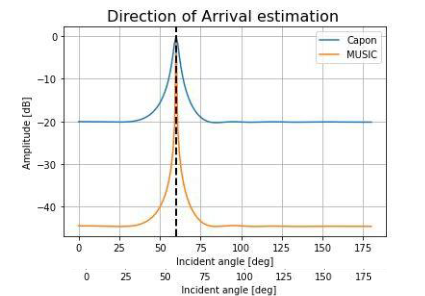Direction of Arrival (DOA) Estimation: MUSIC and CAPON Algorithms Using Sparse Arrays
DOI:
https://doi.org/10.22517/23447214.25240Keywords:
EnglishAbstract
Estimating the direction of arrival (DOA) is crucial for signal localization in various applications including wireless communications, mobile communications, radar,
sonar, and smart antenna technology. This study investigates the performance of the MUSIC (Multiple Signal Classification) and CAPON algorithms for DOA estimation utilizing different array geometries. The incorporation of sparse arrays aims to enhance DOA estimation performance in terms of robustness (addressing mutual coupling effects) and degrees of freedom (resolving sources as effectively as possible with the same number of array elements). Through simulations, we compare the DOA estimation performance of various arrays, such as Uniform Linear Array (ULA), Coprime, Cascaded, and Nested arrays. Additionally, we demonstrate that the choice of array geometry can impact the performance of DOA algorithms. The results present pseudo spectra for DOA estimation methods across all considered array configurations. This study endeavors to identify the algorithm that delivers superior accuracy across different array configurations, which holds significant implications for practical applications requiring precise DOA estimation.
Downloads
References
[1] P. N. Obimo and O. Tamer, ”Performance Evaluation of ¨ 1D DoA Estimation for DECOM and UCLA Using MUSIC Algorithm,” 2021 29th Signal Processing and Communications Applications Conference (SIU), 2021, pp. 1-5, doi:10.1109/SIU53274.2021.9477778.
[2] C. -B. Ko and J. -H. Lee, ”Performance of ESPRIT and Root-MUSIC for Angle-of-Arrival(AOA) Estimation,” 2018 IEEE World Symposium on Communication Engineering (WSCE), 2018, pp. 49-53, doi: 10.1109/WSCE.2018.8690541.
[3] Sharma, B., Singh, G. and Sarkar, I. (2015). Study of DoA estimation using MUSIC algorithm. International Journal of Scientific Engineering Research,6, 594–603.
[4] Zhang, K., Shen, C., Li, H., Li, Z., Wang, H., Chen, X. and Chen, J.(2020). Direction of arrival estimation and robust adaptive beam forming with unfolded augmented coprime array.IEEE Access,8, 22314–22323.
[5] Gabriel, W., “Adaptive Processing Antenna Systems,” IEEE Antenna and Propagation Newsletter, pp. 5–11, Oct. 1983.
[6] M. W. T. S. Chowdhury and M. Mastora, ”Performance Analysis of MUSIC Algorithm for DOA Estimation with Varying ULA Parameters,” 2020 23rd International Conference on Computer and Information Technology (ICCIT), 2020, pp. 1-5, doi: 10.1109/ICCIT51783.2020.9392663.
[7] M. Rahmani and G. K. Atia, ”A subspace method for array covariance matrix estimation,” 2016 IEEE Sensor Array and Multichannel Signal Processing Workshop (SAM), 2016, pp. 1-5, doi: 10.1109/SAM.2016.7569686.
[8] F. B. Gross, Smart antennas for wireless communications: With MATLAB. New York: McGraw-Hill, 2005.
[9] X. Wang, X. Wang and X. Lin, ”Co-prime array processing with sum and difference co-array,” 2015 49th Asilomar Conference on Signals, Systems and Computers, 2015, pp. 380-384, doi: 10.1109/ACSSC.2015.7421152.
[10] P. P. Vaidyanathan and P. Pal, ”Sparse Sensing With Co-Prime Samplers and Arrays,” in IEEE Transactions on Signal Processing, vol. 59, no. 2, pp. 573-586, Feb. 2011, doi: 10.1109/TSP.2010.2089682.
[11] Tie-Jun Shan, M. Wax and T. Kailath, ”On spatial smoothing for direction-of-arrival estimation of coherent signals,” in IEEE Transactions on Acoustics, Speech, and Signal Processing, vol. 33, no. 4, pp. 806-811, August 1985, doi: 10.1109/TASSP.1985.1164649.
[12] Li, Shuang, and Dongfeng Xie. ”Compressed symmetric nested arrays and their application for direction-of-arrival estimation of near-field sources.” Sensors 16, no. 11 (2016): 1939.
[13] B. Bhardwaj, P. G and N. S, ”Performance Analysis of FOC based DOA on Nested Array Elements,” 2021 IEEE Indian Conference on Antennas and Propagation (InCAP), 2021, pp. 336-339, doi: 10.1109/InCAP52216.2021.9726379.

Downloads
-
Vistas(Views): 461
- PDF (Español (España)) Descargas(Downloads): 249
- HTML (Español (España)) Descargas(Downloads): 33
Published
How to Cite
Issue
Section
License
Copyright (c) 2024 Scientia et Technica

This work is licensed under a Creative Commons Attribution-NonCommercial-ShareAlike 4.0 International License.
Copyrights
The journal is free open access. The papers are published under the Creative Commons Attribution / Attribution-NonCommercial-NoDerivatives 4.0 International - CC BY-NC-ND 4.0 license. For this reason, the author or authors of a manuscript accepted for publication will yield all the economic rights to the Universidad Tecnológica of Pereira free of charge, taking into account the following:
In the event that the submitted manuscript is accepted for publication, the authors must grant permission to the journal, in unlimited time, to reproduce, to edit, distribute, exhibit and publish anywhere, either by means printed, electronic, databases, repositories, optical discs, Internet or any other required medium. In all cases, the journal preserves the obligation to respect, the moral rights of the authors, contained in article 30 of Law 23 of 1982 of the Government Colombian.
The transferors using ASSIGNMENT OF PATRIMONIAL RIGHTS letter declare that all the material that is part of the article is entirely free of copyright. Therefore, the authors are responsible for any litigation or related claim to intellectual property rights. They exonerate of all responsibility to the Universidad Tecnológica of Pereira (publishing entity) and the Scientia et Technica journal. Likewise, the authors accept that the work presented will be distributed in free open access, safeguarding copyright under the Creative Commons Attribution / Recognition-NonCommercial-NoDerivatives 4.0 International - https://creativecommons.org/licenses/by-nc-nd/4.0/deed.es license.


